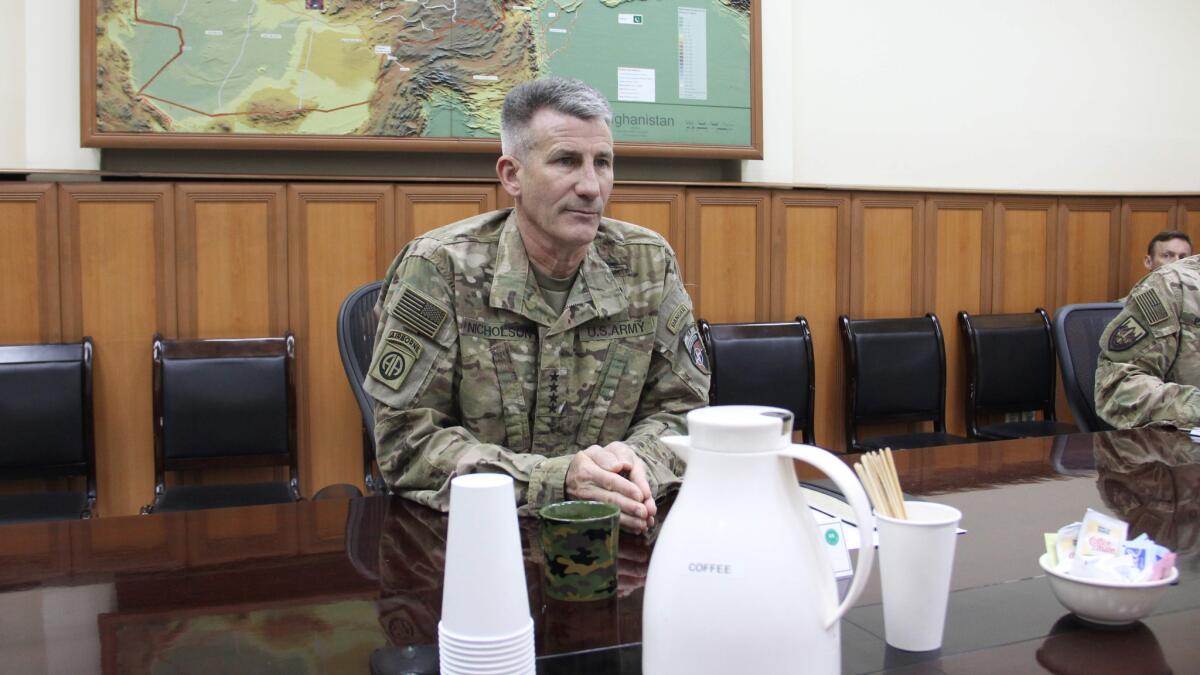Taliban’s deadly onslaught across Afghan provinces draws increased U.S. air power
Reporting from BAGRAM AIR BASE, Afghanistan — One after another, American fighter jets and armed drones screech down the runway at this mountain-fringed northern military outpost, launching missions around the clock to support Afghan forces battling militants aligned with Islamic State and the Taliban.
More than 700 U.S. airstrikes have been carried out this year against the militants, twice as many as last year, as Afghan soldiers and police have struggled to contain a perpetual insurgency.
The ferocity of the fighting, more than 15 years after the U.S.-led military invasion, highlights Afghanistan’s deepening security crisis and unremitting reliance on the United States. The Taliban has waged a campaign of attacks on government-held provincial capitals throughout the country and is expected to continue its assault well into the winter months, beyond what was historically referred to as the “fighting season.”
The Afghan military, riddled with corruption and taking orders from President Ashraf Ghani’s fragile government, lacks intelligence-gathering and other essential capabilities to ward off attacks. As a result, the security forces depend upon American air power and special forces to help them in their fight, two years after President Obama formally ended U.S. combat operations in Afghanistan.
In June, the White House authorized changes to restrictions on airstrikes against Taliban and Islamic State targets, which would be hit only as a self-defense measure to protect forces from harm. The new authorization gave U.S. commanders the power to launch a strike if it promises to bring “strategic effects” on the battlefield.
The move widened the air war by expanding the U.S. military’s ability to provide close air support to the Afghans as they maneuver on the battlefield.
M-9 Reaper drones, F-16 fighter jets and other aircraft here along the windswept flight line at Bagram have dropped about 1,000 bombs so far this year, according to the U.S. military.

Gen. John W. Nicholson Jr., the commander for U.S. and North Atlantic Treaty Organization forces in the country, told a small group of reporters at his headquarters in Kabul, the Afghan capital, on Sunday that the broader authorizations handed down by the White House had “significantly enabled our ability to help the Afghans this year.”
The U.S.-led invasion in late 2001 was aimed at eradicating a sanctuary for Al Qaeda, which had launched the Sept. 11 attacks, and ousting the Taliban from power in Kabul. It proved relatively easy to topple the Taliban, but difficult to pacify or unify a poverty-stricken country ruled by warlords.
The U.S. continues to play a large counter-terrorism role in helping defend the country from the Taliban and a mosaic of Muslim extremist groups including Islamic State, despite more than $4.1 billion in annual U.S. aid to the Afghan military.
Afghan forces are on track to surpass the 20,000 total in casualties sustained last year, including nearly 5,000 dead. Too often, Nicholson said, young soldiers are left ill-equipped at guarded checkpoints, which are routinely attacked by the Taliban.
“This is a failure of leadership,” the general said, adding that an assessment is underway to identify and replace incompetent Afghan commanders.
U.S. warplanes routinely carry out airstrikes to help the Afghans beat back the Taliban at the checkpoints. The Taliban attacks can chip away at public confidence in the Afghan government’s ability to defend its citizens, according to the Pentagon’s most recent biannual report on Afghanistan.
“Perceptions of security remain near all-time lows,” says the report, which examined the situation on the ground from Dec. 1 to May 20. “Twenty percent of Afghans say that security in their community is good.”
Although the Afghan government continues to control city centers, the Taliban holds sway over rural areas and has more territory now than at any time since the war began in 2001, according to recent United Nations estimates.
Brig. Gen. Charles H. Cleveland, spokesman for the NATO mission in Afghanistan, said the Afghan government controls about two-thirds of the population, the Taliban controls about 10%, and the remainder is contested.
U.S. intelligence indicates that the Taliban will make a run on provincial capitals this year as the winter months approach. In the last few months, the Taliban has made several attempts to topple local forces in Farah, Tarin Kot, Lashkar Gah and Kunduz, a town it briefly seized last year.
Currently, about 700 U.S. forces are in Kunduz and Helmand provinces, military officials said, helping advise and coordinate with their Afghan counterparts on beating back Taliban offensives.
Afghan forces, backed by U.S. air power and special operations advisors, have thus far put down the uprisings. However, civilians caught in the crossfire are paying a high price, according to the U.N., which reported that 5,166 Afghans were killed or injured in the first six months of this year — the most since it began tracking casualties in 2009.
“While the Afghan defense of these places has not been perfect and it hasn’t been pretty all of the time … they have been successful and they have defended each of their capitals,” Cleveland said.
For the first time, the Afghans have their own fixed-wing aircraft to provide close air support for their forces. But they have just eight A-29 Super Tucano attack aircraft — with nine pilots.
The new White House authorization has enabled more airstrikes against Islamic State positions, particularly in the eastern province of Nangarhar, where the group has gained strength.
The intensified U.S. airstrikes and deployments of American special forces, called “enablers” by the military, alongside Afghanistan’s 201st Corps helped kill about 100 Islamic State fighters in a 2-week-long campaign this month, according to Afghan Brig. Gen. Mohammed Ali Shujai.
“We will continue to use all the enablers, all the capabilities and all the air assets,” he said through an interpreter.
Twitter: @wjhenn
More to Read
Sign up for Essential California
The most important California stories and recommendations in your inbox every morning.
You may occasionally receive promotional content from the Los Angeles Times.











